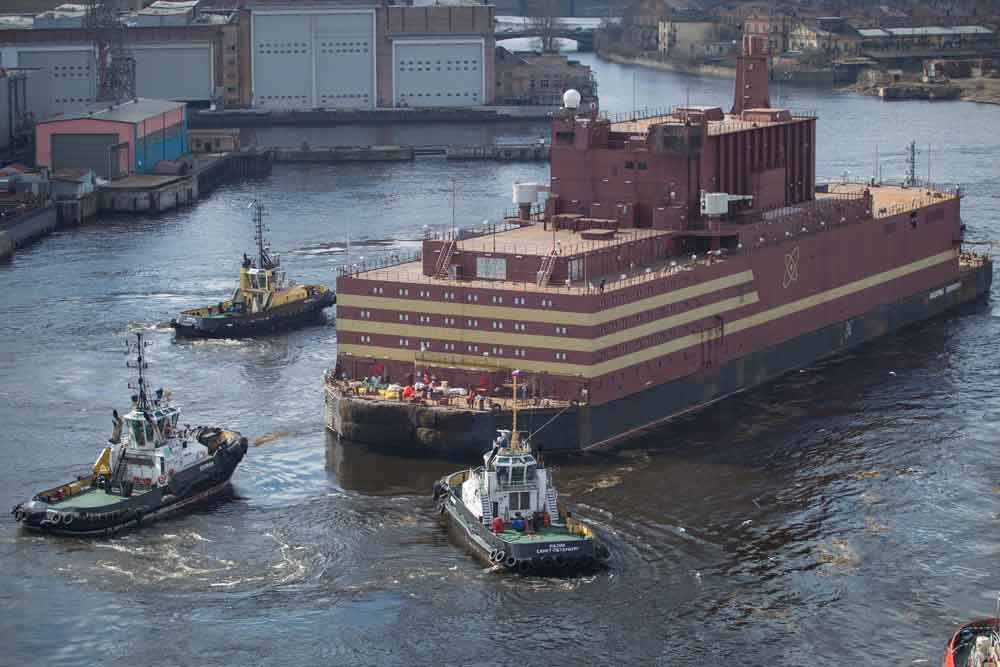Nuclear power plant of the future?
By Dawn Stover | August 29, 2018
 Russia's first floating nuclear power plant began its journey to the town of Pevek, by way of Murmansk, on April 28, 2018. Credit: Rosatom
Russia's first floating nuclear power plant began its journey to the town of Pevek, by way of Murmansk, on April 28, 2018. Credit: Rosatom
Despite a spate of headlines to the contrary, the Russian behemoth currently tied to a dock in Murmansk is not the world’s first floating nuclear power plant. That honor went to the MH-1A Sturgis, built by the US Army and towed to the Panama Canal Zone more than 50 years ago to be used as a portable electricity supply. It is currently being dismantled in Galveston, Texas, a four-year job that is nearly done.
That makes the Akademik Lomonosov, which is basically a giant barge housing two nuclear reactors of the type used on submarines, “for now the only one of its kind,” as the New York Times reported earlier this week. Commissioned by the Russian state nuclear company Rosatom, the floating facility has been under construction since 2010. Its reactors will be loaded with nuclear fuel and started up this autumn, according to Rosatom, and then towed to the seaport of Pevek—about 500 miles from Alaska—where it will replace two aging, smaller power plants and generate up to 70 megawatts of electricity.
Rosatom says the floating plant is designed to provide power to remote port cities, industrial plants, and offshore gas and oil platforms in Russia’s Extreme North and Far East. It will carry enough enriched uranium to power its two reactors for 12 years before it will have to be towed back to Russia for refueling and waste processing. China is also planning to build as many as 20 floating nuclear power plants, which would be similar to the Russian design.
Proponents say that floating nuclear plants have major advantages over land-based power plants: They have easy access to cooling water and can be quickly installed near coastal cities with rapidly growing energy demands. And unlike other types of energy that produce relatively few climate-altering emissions, nuclear power plants can run 24/7.
But as with onshore nuclear reactors, the closely related issues of safety and economics could be showstoppers. Rosatom isn’t saying how much it is spending on the Akademik Lomonosov—a project conceived in the early 1990s, when nuclear power did not have to compete with cheap natural gas.
Publication Name: New York Times
To read what we're reading, click here
Together, we make the world safer.
The Bulletin elevates expert voices above the noise. But as an independent nonprofit organization, our operations depend on the support of readers like you. Help us continue to deliver quality journalism that holds leaders accountable. Your support of our work at any level is important. In return, we promise our coverage will be understandable, influential, vigilant, solution-oriented, and fair-minded. Together we can make a difference.
Keywords: Akademik Lomonosov, MH-1A Sturgis, Russia, floating nuclear power plant
Topics: Climate Change, Nuclear Energy, What We’re Reading
















The nuclear reactors used on the barge come from ice breakers, not submarines. https://en.wikipedia.org/wiki/RITM-200 Also, SCIAM https://blogs.scientificamerican.com/guest-blog/breaking-the-ice/
Thanks for that correction! This “What We’re Reading” item was based on the New York Times article linked at the bottom, which reported that the floating plant is “made of two miniature reactors of a type used previously on submarines.” I should have relied on my own earlier reporting for the Bulletin, where I noted that the Russian design uses “a modified reactor from a Russian icebreaker”: https://thebulletin.org/2016/06/floating-nuclear-power-plants-china-is-far-from-first/.
I don’t like this. It is vulnerable to attack. In an age of Saudi financed terrorism, this is a radiological nightmare of a catastrophe in the making.
Production line mini nuclear batteries is the obvious way to go , the barge format a good first step to introduce the next generation technologies.
A nod from politicians and market investment now please.
Floating nuclear plants like Akademik Lomonosov still will not have to compete with “cheap natural gas.” As noted in the article, they are intended for use in places where pipeline gas isn’t available and where LNG deliveries would be difficult and expensive. Instead, they will generally have to compete against distillate fuels burned in compression ignition (Diesel) engines. The fuel and engine combination that current powers many remote areas in the world often has costs per kilowatt-hour in the range of $0.50 to $1.00. It’s also a smoky, rather noisy configuration with machinery that is not as reliable as a… Read more »
“Instead, they will generally have to compete against distillate fuels burned in compression ignition (Diesel) engines.” Indeed. The Western version of this floating power plant is precisely that: a huge marine diesel engine powering a generator, mounted on a barge. And since both are intended as interim solutions, while the on-shore facilities of a coastal city are expanded to meet an increasing demand for electricity, this economic argument doesn’t hold water at all. While the fundamental solution is to reduce electricity consumption, of course (“Negawatts not megawatts”), the choice between these two should depend on assessment of the special risks… Read more »
They’re not subject to tsunamis: that makes this type of plant the solution to the problems Japan faced, so in the long term there will be a resurgence in the use of nuclear power?
I suggest you take a look at the photos of ports after a tsunami has hit: ships washed far ashore, and others lying on their sides after toppling over in the initial withdrawal of the sea. If anything, they are more vulnerable. And it would take considerably longer to get them out to sea and out of harm’s way than normal ships.